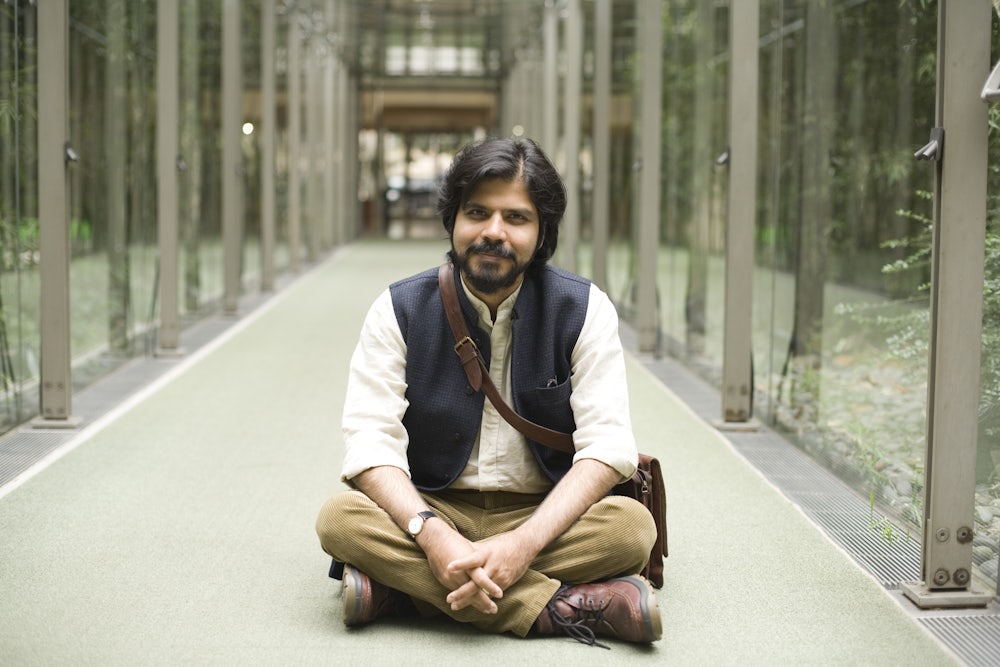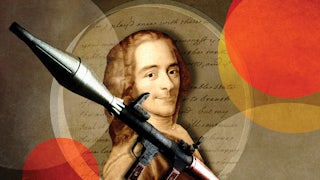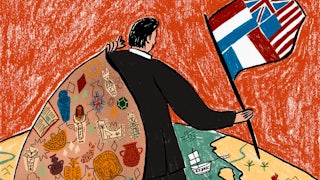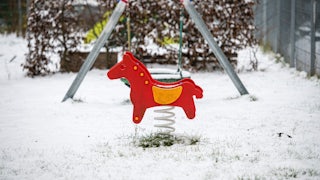There is a moment in Pankaj Mishra’s new novel, Run and Hide, when a young billionaire introduces his old college friends to the new world he inhabits, of summers in the Hamptons and homes scattered over several continents. “Look at us man,” the young man, Virendra, reflects, “all grown up and shit, here in the US of A.” He starts to sing, “Waqt ne kiya kya haseen sitam”—“time has enacted a beautiful crime.” His friends stand by, admiring the scenery. “But it’s true isn’t it?” he reasons. “We could have been like our parents, totally without power, totally helpless and trapped. We had to escape. Who would have thought it possible? But we did it.”
The scene encapsulates the enduring dilemma of those born into circumstances they wish to leave behind. These “self-made” men or women must manufacture new selves, build them up from scratch by imitation or imagination. This project of self-construction is the preoccupation of Mishra’s three main characters: Arun, Aseem, and Virendra, all from “humble backgrounds,” all sulkily bound together by having been students at the prestigious Indian Institute of Technology. The moment at Virendra’s country home is a reckoning of sorts. Having accumulated immense wealth, he is showing off his new self to his old buddies of lesser means. The second stanza of the song he sings goes, “I am no longer I and you are no longer you.” It is a conundrum. How do those who are “self-made” stay true to themselves?
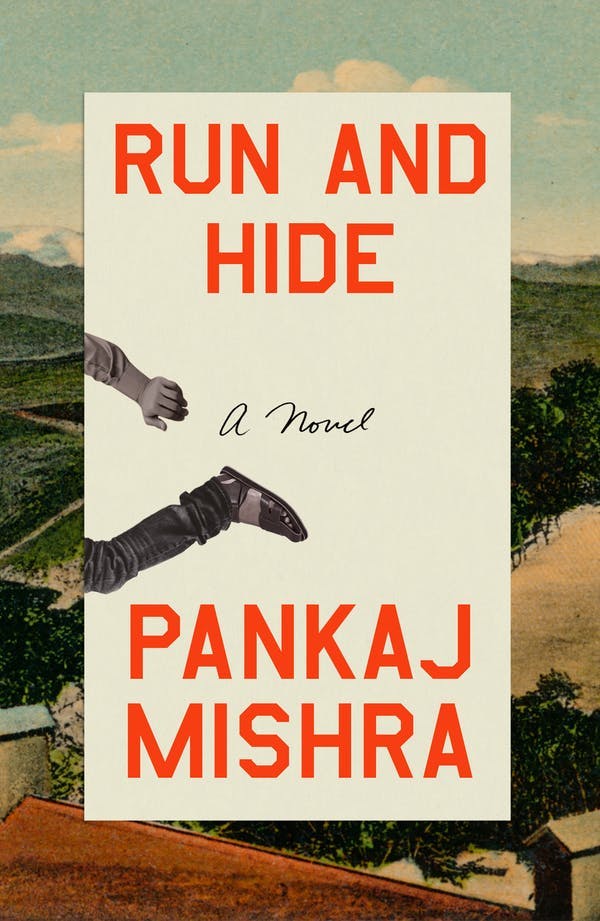
This central question of authenticity, of the costs of being self-made, haunts Mishra’s novel. Mishra, long a prescient critic of the neoliberal jargon used to describe ever-emerging India, now returns to fiction—a genre he last inhabited when his debut novel, The Romantics, was published in 1999. It is a remarkable return, one that articulates just how uneasily the pressure of Indian cram schools intersects—eventually and if things go well—with the promises of the West.
The task of exorcising inadequate selves begins at IIT, where the central characters are subjected to a ghastly initiation ritual involving repeated sexual assaults. (Of the three, one is forced to perform the act, another to endure it, and the third to masturbate to the scene, the entire tableau carried out per the commands of an upperclassman.) It is a gritty and humiliating beginning to their new lives, and having shared it unites the trio in an awkward and weaponized version of trauma bonding. Though never close friends or confidants, they go on to share a tiny room at the IIT hostel, and their lives intersect and overlap in the years to come. Having met and known and lived with each other’s original “pre-made” selves means that each can serve as an authenticity barometer of sorts for the others. Has the essential been retained, or has too much been erased?
On the Virendra of the Hamptons, our narrator Arun provides a snap judgment: “Nothing in the Virendra I knew at IIT had foreshadowed this unhealthy fleshiness and his conviction of having achieved complete liberation from the life of his parents.” The Virendra he had known was the lower-caste son of impoverished parents, thin as a reed and so poor that he wore a ladies’ watch and obsessively polished his shoes to hide their age. Aseem has achieved modest literary success—enough to make him, in his forties, the go-to authority on the Indian literary firmament, a tastemaker of sorts who hosts get-togethers in his apartment, furnished appropriately with Indian crafts.
Arun has his own demons to wrestle. In evocative prose, Mishra leads his reader into the claustrophobic inner environs of the desperately wanting. Arun’s childhood home “is a small kothri (room) with beige colored walls and two high and narrow windows that lashlessly squint out at the yard.” So tiny is the place that its whole is taken up when the family of four lays down to sleep at night. There is no kitchen; Arun’s mother cooks outside. Nor is there a bathroom; instead the family squats on the railway tracks between 5:30 and 6 a.m., when there is a lull in train traffic through the station. In order to attend the coaching classes he needs to get into IIT, Arun has to literally wrest the sweaty notes from his father’s hands.
There is no romanticization of poverty in Run and Hide. The details of a meager existence, the dented and stolen aluminum trays on which the family eats, the turds that must be dodged on the way to the sewer come together in Mishra’s prose to create an unforgivable panorama of want. The novel’s only deliverance is that Arun has escaped it. He also manages to rescue his mother when he sets up household in a faraway Himalayan village to translate Hindi fiction. As he puts it, “the inferiority which spurred fantasies of power in Aseem and Virendra, had worked away inside me into a kind of guilt for wanting too much from the world.” There he remains, until the arrival of Alia, a Muslim journalist of some pedigree who shows up to ask him questions about his time at IIT, prizing open the Pandora’s box that is Mishra’s novel.
The central conceit of Run and Hide is a correction of the record. Alia has already written up a book about the trio and the legendary institution IIT that brought them together decades ago. The institution has begun to occupy a mythic place for its role in the lives of Indian men who have gone on to worldwide prominence (even if they end up in trouble ultimately or along the way). Alia selected this group because she felt they represented a typical trio in whose stories the transformative power of IIT as a maker of lives and fortunes, a means of deliverance from poverty, lower-caste exclusions, and other inherited misfortunes could be underscored. Now Arun, having read that work, is offering up his own version, which he wants us to believe is the truer account. Correction is a preoccupation not limited to Arun: Aseem and Virendra are living out correctives of their own at the “correctional facilities” (think: white collar crime) where they now reside.
Sharp and propulsive, Run and Hide offers up corrections of its own. The India of Run and Hide is as preoccupied with authenticity and becoming as its three main characters are. The literary festivals and book talks that Aseem arranges and that Virendra funds are their own version of a Hamptons mansion—dazzling fronts to obscure the humiliations and feelings of inferiority that make up the past. Run and Hide seeks to take readers beyond these performances of enlightenment and toward the country’s darker truths, represented by men like Arun’s father, entirely seduced by Hindu nationalism and its fantasy of a Hindu supremacist future.
Like the three protagonists, India is in the process of becoming a “new” country. Like Arun, Aseem, and Virendra, it is enmeshed in both the euphoria and the burden of great potential. Just as Arun can evaluate whether his old classmates have milked every drop out of every opportunity presented to them, so too does Mishra probe whether India’s own becoming, its transformation from potential superpower to Modi’s Hindu nationalist haven, is worthy of applause.
Back at the Hamptons, Virendra does a curious thing before he leads his schoolfriends into a tour of his mansion. Noticing that the gravel of his driveway has been disturbed by the rental car his friends have arrived in, he uses his sandaled foot to smooth it out. It is a barely noticeable gesture but one that an astute observer would recognize as the habit of those who are afraid to muss up their good things, those who never remove the plastic wrap from their furniture and never use their good china. In this subtle gesture is maybe an indication regarding the possibility of transformation. Maybe our poor and wanting selves are our only authentic ones, and all others performances of convenience or necessity. Perhaps there is no such thing as a self-made man.
